
Features
Efficiency
Energy
LEDs in spotlight
March 8, 2012 By Dr. Elly Nederhoff
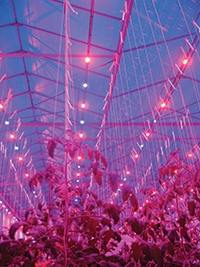 Lemnis LED lights with water cooling in a large-scale trial in tomatoes at Redstar (the Netherlands).
Lemnis LED lights with water cooling in a large-scale trial in tomatoes at Redstar (the Netherlands). Introduction: Artificial lighting in greenhouses is common practice in greenhouses in northern Europe and Canada. It’s necessary for growing crops like tomatoes and roses through winter. In the Netherlands alone, an estimated 2,000 hectares of greenhouses are lighted. The standard lamp used since the 1990s is the high-pressure sodium (HPS, SON-T-Agro). Obviously the investment and running costs of lighting are high.
When LED lighting was introduced into the horticultural market in 2007, salespeople promised extremely high efficiency and exceptional yields thanks to special light colours. However, test results in the first winter season were disappointing, and so was the efficiency. In the second and third season, the results were mixed. Depending on circumstances, LEDs gave lower, equal or higher yields than HPS lamps. This was under equal light levels, expressed in micromol/m2/s. Meanwhile, several practical applications are doing really well. Important differences between LED and HPS are the spectrum (light colours) and heat delivery, as well as the price.
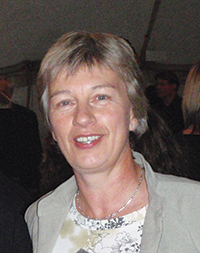 |
| Dr. Elly Nederhoff |
HPS lighting: HPS lamps have pros and cons. HPS provides a good spectrum (mix of light colours), which has proven to work well for plants. The so-called wall-plug efficiency of HPS lamps is in the order of 30 per cent. Thus, of the incoming electricity, about 30 per cent is converted to light and the remaining 70 per cent is converted to heat. This is very good compared to incandescent lamps (six per cent light), but 70 per cent “loss” is still a lot.
Extra heat in winter is mostly beneficial, as it increases the air and plant temperature. But under milder weather conditions, the heat from HPS lamps can be excessive. Then thermal screens and even vents have to be opened, which is a waste of energy. With screens partly open, some light escapes and this is regarded as “light pollution” in the Netherlands. Another disadvantage is that the reflectors of HPS lamps cause shading (light loss) all year round.
LED lighting: Unfortunately, most LEDs are not much better than HPS in wall-plug efficiency. In the order of 30 per cent of electricity is converted to light and 70 per cent to heat (note that LEDs have a wide quality range).
The difference is that the large HPS lamps deliver a huge heat load on one spot, whereas the small LEDs give a nicely distributed heat output. Moreover, LEDs produce heat at the back. This heat is dissipated in the ambient air, or can be removed by water-cooling (e.g., Lemnis systems), which can be an advantage. Therefore with LED light, there is no overheating and screens don’t have to be opened, so there is no “light pollution.”
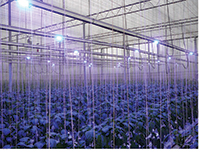 |
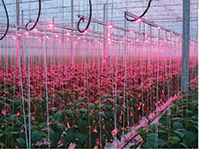 |
| Testing the effect of different light colours for crop steering in capsicum (at Dingemans, Netherlands). |
Other advantages are that LEDs run on low voltage, and can be dimmed (in principle). However, LED lighting is still much more expensive than HPS lighting. It is expected that the price will come down when supply increases further.
Spectrum: Spectrum is the mix of light colours. Light colour is characterised by wavelength, e.g., red has wavelength around 650-700 nanometer (nm). HPS lamps produce a mix of yellow, orange and red, plus some blue light. In contrast, one individual small LED produces one colour only, and there is a range of colours available.
Manufacturers select LEDs of different colours and combine them in a LED module (array). Custom-made LED modules give exactly the spectrum required for a certain application. A different spectrum is required for growing with or without natural light, e.g., in a greenhouse, multi-layer cultivation or growth room. For tomatoes in green-houses, the popular choice is mainly red light (say 90 per cent) with some added blue (10 per cent). Red light is “cheapest” (because less electricity is needed to produce one mol of red light than to produce one mol of blue light). Blue LEDs are added to get optimal plant shape.
INTERLIGHTING AND OVERHEAD LIGHTING
Because the heat from LEDs is nicely spread out, LEDs can be placed much closer to the plants, even between the plants (“interlighting”). Light between the plants keeps the lower leaves alive longer, while the mild warmth from the LEDs keeps the plants dry, and thus reduces fungal diseases. In addition, perhaps less light is lost.
Plant temperature is another factor, even with LEDs installed overhead. HPS lamps radiate a lot of heat directly on the heads of the plants, whereas LEDs don’t do that. This may cause small differences in head temperature, development rate and/or transpiration, which have advantages and disadvantages.
GROWTH DEPENDS ON LIGHT INTENSITY
Two main processes in plants are growth (weight gain) and development (shape). Growth rate depends on the rate of photosynthesis or assimilation (CO2 uptake), which in turn depends strongly on the amount of light. The light quality (light colour) is less important, because photosynthesis responds well to any colour of visible light (waveband 400 to 700 nm).
So more light means more photosynthesis. Growers in the Netherlands choose light intensity for LED light between about 100 and 200 micromol/m2/seconds, and use the lights for up to 18 hours a day. This raises the daily light sum in winter to (early) spring levels. It is very important to use the correct units, especially when comparing HPS and LED. The only correct unit is micromols per m2 per second. This is called the Photosynthetic Photon Flux (PPF). Light measurements in Watt, lux, lumen, candela, etc., are not good.
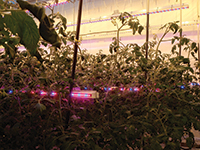 |
| Philips LEDs are shown here in overhead lighting and inter-lighting at Wageningen University in Bleiswijk. |
PLANT SHAPE DEPENDS ON LIGHT COLOUR
Plant development and plant shape depend on the light quality, which is the light colour or spectrum. Blue, red and far-red light are especially important, as is the time of the day when these particular colours are given – at night, day, morning or evening. These colours can steer flower initiation, stretching, branching, plant balance, stomata opening and more. This is known as “plant steering” (officially “morphogenesis” and “morphogenic effects”).
A lot of research is now focusing on the effect of light colours. Scientists want to understand the “hidden effects” of light colours in LED light on tomato and rose plants, e.g., on stretching, branching, bud formation, etc. Other scientists are working on flower initiation in ornamental plants that are normally long-day or short-day plants. These plants can be tricked into flowering “on demand” with special colour treatments. When light colour effects are better understood, growers will be able to avoid unwanted side-effects and to use LEDs for accurate control of how plants grow, develop, flower and produce.
LED systems: There are some special requirements for application in greenhouses: right spectrum, water-proof, robust, reliable, stable and causing minimal shading of
natural light.
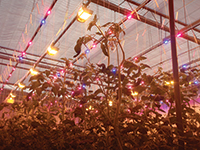 |
| One of the treatments in an experiment at Wageningen University in Bleiswijk features a combination of HPS and overhead LED lighting. |
Two examples of specialized horticultural LED systems are: Philips GreenPower LED and Lemnis lighting LED modules. Lemnis LEDs have water-cooling. Both manufacturers provide custom-made solutions (light colour, light level, number of LEDs, dimensions). Systems are available for assimilation lighting, multi-layered cultivation or cyclical lighting. New modules are being developed continuously.
The future: Knowledge on LEDs has increased rapidly in the last three winters, but new questions arise all the time about the finer art of growing under LED lighting. In a later article we can summarize the conclusions of in-depth research done in the Netherlands on growing tomatoes under LEDs.
LEDs can have a bright future if their efficiency increases and the price comes down, and if scientists continue to gain new knowledge, and growers learn more about how to grow best with LED light.
Elly Nederhoff (PhD), CropHouse Ltd, New Zealand, Elly@crophouse.co.nz, is a consultant for greenhouse technology and guest scientist at Wageningen University and Research Centre in the Netherlands.
Print this page